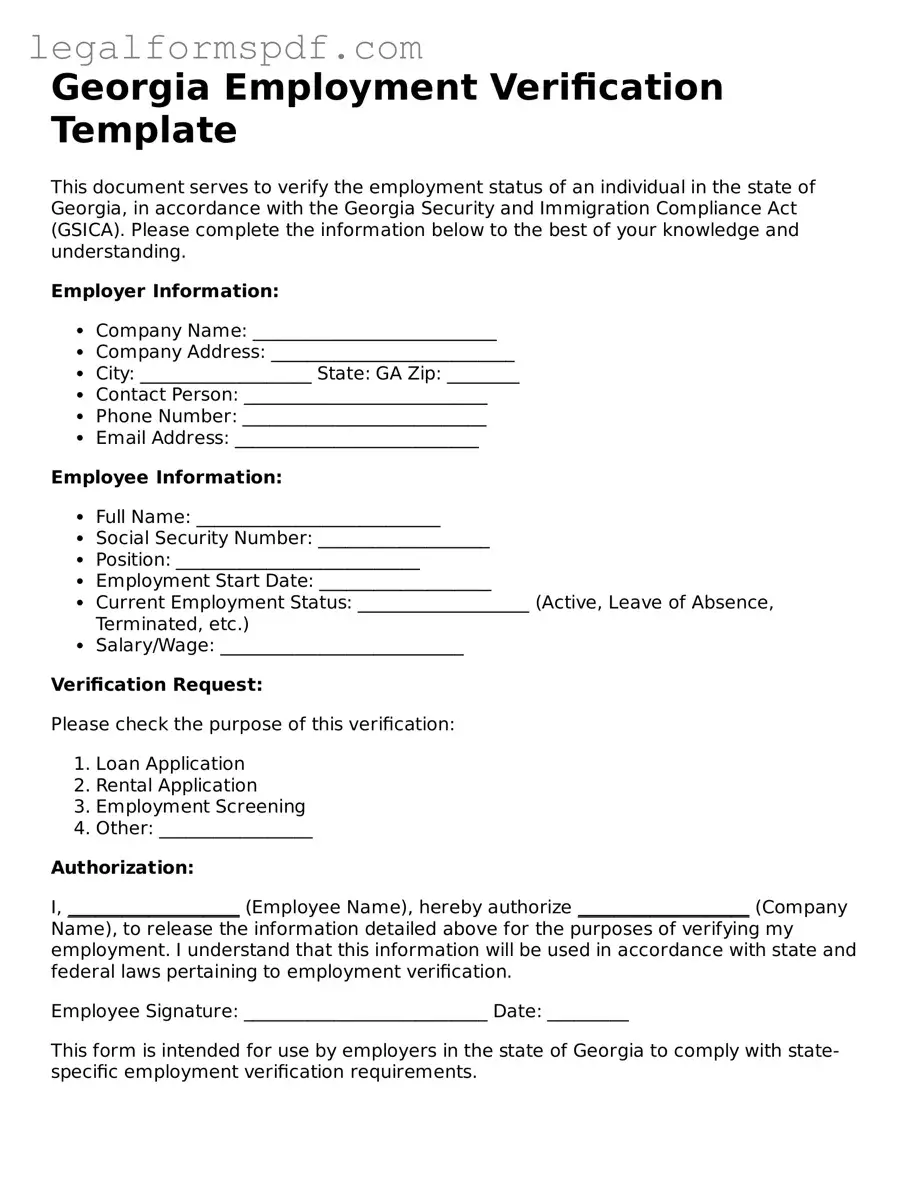The Georgia Employment Verification form shares similarities with the I-9 Employment Eligibility Verification form used across the United States. Like the Georgia form, the I-9 is required by federal law to confirm the eligibility of employees to work in the U.S. Both forms require employees to present documents proving their identity and employment authorization, although the specific documents accepted may vary. The purpose behind both forms is to prevent illegal employment, but the I-9 is a broader requirement applicable to employers nationwide.
The W-4 form, known as the Employee's Withholding Certificate, is another document related to the Georgia Employment Verification form, albeit with a different focus. While the Georgia form verifies employment eligibility, the W-4 helps employers determine the correct amount of federal income tax to withhold from employees' paychecks. Despite this different primary function, both forms are standard steps in the hiring process, ensuring that employees are legally compliant and financially accounted for from the start of their employment.
Akin to the Georgia Employment Verification form, the Employment History form is utilized by employers to gather a candidate's past job experiences. Although the Employment History form focuses more on verifying the employee's career trajectory and qualifications for the job, both forms serve the fundamental purpose of vetting individuals during the hiring process. They collectively ensure that candidates are both eligible to work and suitably experienced for their positions.
The Direct Deposit Authorization form is another document employees often encounter when starting a new job, like when they complete the Georgia Employment Verification form. This authorization form allows an employee's wages to be directly deposited into their bank account. Despite its different function, focusing on the logistical setup for receiving pay, it is part of the broader suite of documents that facilitate a smooth employment commencement, ensuring employees are work-eligible and financially organized.
Reference Check forms bear similarity to the Georgia Employment Verification form in their mutual emphasis on verifying aspects of a candidate's background before finalizing employment. While the Georgia form checks for legal employment eligibility, Reference Check forms evaluate the character and work ethic of the candidate, based on previous employers' or mentors' testimonies. Both processes are critical to making informed hiring decisions, aiding employers in assembling a reliable and qualified workforce.
The Non-Disclosure Agreement (NDA) can also be linked to the Georgia Employment Verification form through their shared role in establishing the terms of employment. An NDA specifically addresses the confidentiality requirements for employees, protecting proprietary information. Although addressing different concerns—eligibility to work versus confidentiality—the signing of both documents marks important steps in formalizing the employment relationship, setting expectations, and defining boundaries.
The Background Check Authorization form, which grants employers the permission to conduct a criminal or financial background check, parallels the Georgia Employment Verification form in its focus on pre-employment screening. Both aim to ensure the reliability and integrity of the workforce by verifying critical information before employment commences. While the Georgia form is specific to work eligibility, the Background Check Authorization covers a broader spectrum of potential employee risks.
Employee Handbook Acknowledgment forms, much like the Georgia Employment Verification form, are integral to the onboarding process. This acknowledgment form typically signifies that the employee has received, read, and understood the company's policies and procedures. Although its content differs by focusing on operational and behavioral expectations within the company, it complements the employment verification process by ensuring that employees are not only legally eligible to work but are also aware of their responsibilities and the company culture.
The Health Insurance Eligibility form is part of the suite of employment-related documentation, similar to the Georgia Employment Verification form, in that it concerns another aspect of employment eligibility—benefits eligibility. While the Georgia form validates the legal eligibility to work, the Health Insurance Eligibility form determines whether an employee qualifies for the company's health insurance benefits. Both are crucial steps in establishing the terms and benefits of employment, contributing to a comprehensive understanding of an employee's position and privileges within the company.
Lastly, the Safety Training Completion form, which employees must often fill out upon completing mandatory safety training sessions, shares the goal of the Georgia Employment Verification form in ensuring workplace compliance. Whereas the Georgia form confirms compliance with employment eligibility laws, the Safety Training Completion form documents compliance with safety regulations and training requirements. Together, they underscore an employer's commitment to legal adherence and a safe working environment for all employees.
